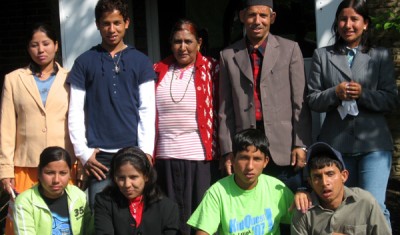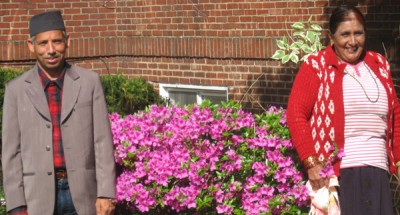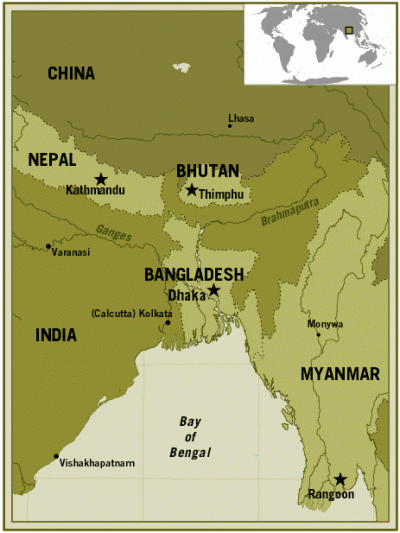A Bhutanese Family in Pittsburgh
by Sampsonia Way / August 9, 2011 / No comments
In 2008 Nepali journalist Deepak Adhikari was completing an Alfred Friendly Press Fellowship with the Pittsburgh Post-Gazette. In 2010 he contacted Sampsonia Way to follow-up on a family of Bhutanese immigrants he profiled while in Pittsburgh. The family was re-located to this city in 2008 from a refugee camp in Nepal where they had been living for eighteen years.
Based on the text that Adhikari wrote about his encounters with the Odari family and an interview that Sampsonia Way intern Olivia Stransky conducted with them in 2011, we are able to share some of the Odari family’s experiences with you today.
Background
In the late 1980s and early 1990s Bhutan, a Himalayan nation between China and India, began a campaign of ethnic cleansing against the Lhotshampa, a group of historically Nepalese immigrants living in Southern Bhutan. Under the so-called “One Nation, One People” policy, the Bhutanese government stripped the Lhotshampa of their citizenship in a state-orchestrated attempt at cultural homogeny.
The government, dominated by the Ngalong ethnic group, passed laws in the 1980s requiring all citizens to speak Dzongkha, the national language, and wear traditional Ngalong attire in public. In 1985 the Bhutan Citizenship Act was passed, denying citizenship to anyone who could not prove residency in Bhutan prior to 1958. The state unleashed a series of crackdowns on largely peaceful demonstrations which led to the expulsion of over one hundred thousand Bhutanese, making Bhutan the source of the highest number of the world’s refugees in proportion to its population.
Because of the country’s geographical isolation, the state—to a large extent—was able to get away with the act. With the country promoting the headline-grabbing concept of Gross National Happiness very little international attention was paid to this humanitarian crisis. The lack of unity between refugee-supported political parties combined with the failure of bilateral talks between Bhutan and Nepal (which gave refuge to the Lhotshampa) also slowed the repatriation process to a stand-still. Tensions rose as the situation dragged on, edging toward violence from the influence of Maoist splinter groups based in the refugee camps.
In 2006 the United States entered into the fray with an offer to resettle up to 60,000 Bhutanese refugees from seven refugee camps in southeastern Nepal. A few European countries as well as English-speaking countries like Canada, Australia, and New Zealand joined hands with the US. The resettlement program—described by the UNHCR as the world’s largest—started in early 2008.
Prospect Park
Incidentally, in mid-March of 2008, I was traveling to the US to participate in a six-month Alfred Friendly Press Fellowship, a cultural and professional exchange program between international journalists and the American press. On my Dragon Air flight from Kathmandu to Hong Kong, I was surprised to find around two dozen Bhutanese refugees who were heading for New Zealand under the resettlement program. I conversed with Tika Ram Karki, a former teacher who was very enthusiastic about his new life.
Little did I know that further surprises would be awaiting me in Pittsburgh, the city where I would spend most of my US trip, working at the Pittsburgh Post-Gazette. One afternoon in early April, 2008, the Post-Gazette photographer Andy Starnes and I left for Prospect Park in Whitehall where we met three siblings of the Odari family: Man Maya, Yani Maya, and Dilli Prasad.
Three young people who have never ventured out of their sprawling, dusty refugee camps –a cluster of small huts with thatched roofs and dirt floors– thrust into the well-furnished apartments of suburban Pittsburgh. But more than that, as Man Maya told me later, it was their language and the sight of a familiar-looking face that they were longing for since their arrival in late March. They were elated to find those characteristics in me. A month later, their parents, Bhawani Prasad and Lachhi Devi, and the remaining four siblings—two brothers, Jaya Narayan and Tul Prasad, and two sisters, Durga Devi and Meena Kumari—joined them in Whitehall, marking an end to their loneliness in an alien world.

(Clockwise from top left) Durga Devi, Dilli Prasad, Lachhi Devi, Bhawani Prasad, Man Maya, Jaya Narayan, Tul Prasad, Meena Kumari, Yani Maya. Photo by Deepak Adhikari
In the following months, with help from Catholic Charities, more and more Bhutanese refugees started to arrive in Pittsburgh, turning the trickle into a rushing stream. A ‘little Bhutan’ began to take shape in Whitehall, an area previously settled by Iraqi and Burmese refugees.
As I mingled with the Odari family, just settling into their new home, I found out that what they wanted most was to tell their stories about life in southern Bhutan, the years spent in the refugee camps of Nepal, and their expectations and struggles to rebuild their lives in Pittsburgh.
The patriarch of the family is Bhawani Prasad Odari, a robust 53-year-old man who always wears a cone shaped, embroidered Nepali cap. He can read and write in Nepali, but not English (while being interviewed for a job at a food packaging factory, he requested that he be given a job that required little communication). Bhawani Prasad was originally a farmer in Bhutan, and he still vividly recalls the moment he decided to leave his homeland.
The family of nine left Bhutan on March 14, 1992, their hasty flight allowing them to take only what they could carry. For Bhawani Prasad and his wife Lachhi Devi that meant their Bhutanese citizenship certificates and some belongings. “I only had three thousand rupees (about $50) with me and I had to take my family to a safer place,” Bhawani Prasad recalls. Fortunately, sensing the growing tension in his neighborhood, he had already sold his cattle. “But we had to leave our food, possessions, and the house,” he laments.
Why did he decide to leave? Out of Bhutan’s total population of seven hundred thousand, there are still two hundred thousand Nepali-speaking Bhutanese inside the country. Bhawani Prasad answered that a combination of pressure from his extended family, as well as threats from both the opposition parties and the state, forced him to make the decision to leave. Referring to the political unrest of the 1980s and 90s, he says, “Some students were arrested while others arrived in our village and instigated us to stage protests.”

Bhawani Prasad and Lachhi Devi. Photo by Deepak Adhikari.
He did not participate in the protests, but he and others like him were caught in the middle. He says, “If we participated in the protests organized by political parties like the Bhutan People’s Party, we would be targeted by the government. If we didn’t, the cadres of the political parties would not spare us.” Torture, beatings, murder, and rape continued in southern Bhutan and when Bhawani Prasad heard that his parents and his brother’s family were fleeing their home, he decided to join them. They ended up in the Beldangi refugee camp in southeastern Nepal.
I ask Yani Maya, his 24-year-old daughter, about life in the camps where she grew up. Her typical day started at 3:30 in the morning. She would study for school until 4:30 am. “Then I would take the plastic buckets to the water tap,” she recalls. “We had to queue up in order to get water because it was only during that time that the water tap ran.” Under dim kerosene lamps (because there was no electricity in the camps), she would do her homework until daybreak.
Though I had visited the refugee camps a number of times as a part of my reporting, I was struck by her experience. One particular incident illustrated the precariousness of life in the camps. During the spring season, a storm wreaked havoc in Nepal’s southern plains. Many ordinary Nepalis fell victim to the storm’s fury, but refugees were hit even harder. “We would often grab a part of the roof, lest the storm would blow it away,” Yani Maya reminisces. “In retrospect, it sounds funny but it was really hard to maintain our lives in the camps,” she says, sitting in her cozy Prospect Park apartment, surrounded by her family members. Currently she is working with her family and others from the Bhutanese community at Quality Driven Copack, a food packing plant in Charleroi, Pennsylvania. In a few years, she hopes to continue her studies, which were interrupted due to the resettlement.
In late August 2008, I was winding up my stay in Pittsburgh and heading to Washington DC, where after a week-long detour, I had plans of flying back home in early September. On the day of my flight, as I was packing my things, Yani Maya, Dilli Prasad and Meena Kumari showed up at my apartment. However hard I tried to maintain the distance between what we call ‘journalist and his subject’, dictated by the norms, human relations had already defied that. It was really hard for me to say goodbye to these three young refugees whose eyes danced with optimism for new life in America. Thanks to the Odari family who welcomed me into their lives and their stories, never in my life had I become so deeply attached to a place and a community in such a short span of time.
Deepak Adhikari is a Kathmandu-based journalist whose work has appeared in TIME magazine, The Guardian, Foreign Policy in Focus, and Open Democracy, among others. He’s been covering Bhutanese refugees for several years and has also edited Torture Killing Me Softly a prison memoir of Bhutanese leader Tek Nath Rizal.





